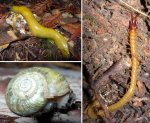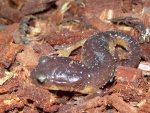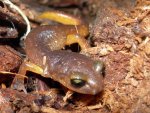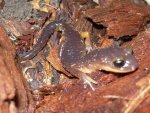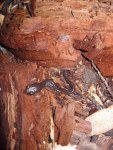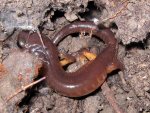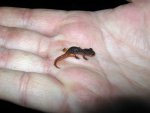pete
Active member
- Joined
- May 7, 2007
- Messages
- 550
- Reaction score
- 30
- Points
- 28
- Location
- CA
- Country
- United States
- Display Name
- Pete
I had the opportunity to explore the caudates of the redwood forests of the south bay. I have done a number of herping in the north and east bay prior. This trip I had hoped to stumble across a terrestrial adult Dicamptodon (I only ever found larvae in the north bay) or find a Black Salamander Aneides flavipunctatus .
Actually, I took two trips to the same place, but for the first trip (5 days ago) another guy was photographing, so I don't have the photos yet. All we really found that time were a bunch of Ensatinas, and a lot of them. Curiously, it was often 2 Ensatinas under each log. I didn't see any eggs, though. I went back today and headed downstream this time. It was very cold and foggy. The fog made all of my habitat pictures come out blurry because I couldn't use my flash. Shown very nicely below in the "without/with" flash photo. Redwood forests can be quite dark and this one was. Lighting was a real challenge on this trip. Photography in general was tough, because my hands were freezing and slow to respond, and everything was moist, so debris was sticking to everything.

Unfortunately, I didn't find any of the caudates I had hoped to, but I did find a bunch of caudates and the patternings were quite different than those I found in the north or east bay. Generally these guys were all more speckled than I was used to seeing. Most were under debris near the streams. I wandered to higher elevations where the forest was more recently logged contained more Douglas fir trees, but there I found no caudates there. So here were the finds.
A few Slenders, One was notably more speckled than I'm used to seeing, but as a whole they seemed darker in overall color, too.




This guy fell out of a rotting log that I turned. It didn't want to uncoil. It looked like a very warm pose in the chilly forest.

A pair that I didn't disturb too much for photographing in case they were in the middle of making more salamanders.

There was only one ensatina this time, and unfortunately I didn't get any great photos.

I found one Aneides. I suspect is an arboreal, but it was much smaller, thinner and more speckled than I was used to seeing.


The feet and tail on these guys are pretty cool.

I also found these two tiny guys in close proximity that were hardly 2 inches (5 cm), had disporportionately large heads and lots of speckles. Initially, I thought they were young Ensatinas because of the orange legs, however I've never seen such a speckled ensatina. And none of the dozen ensatinas we found a few days earlier were speckled like this, although they were all clear adults. Now, I'm wondering if maybe they were baby Aneides, maybe someone more experienced can make a more definative ID (Where's Rust?).
Salamander 1



Salamander 2

And finally, to spin it in a caudate fashion. I found some Dicamptodon food. The famous banana slug. This guy was about 6 inches (15 cm) long.


Actually, I took two trips to the same place, but for the first trip (5 days ago) another guy was photographing, so I don't have the photos yet. All we really found that time were a bunch of Ensatinas, and a lot of them. Curiously, it was often 2 Ensatinas under each log. I didn't see any eggs, though. I went back today and headed downstream this time. It was very cold and foggy. The fog made all of my habitat pictures come out blurry because I couldn't use my flash. Shown very nicely below in the "without/with" flash photo. Redwood forests can be quite dark and this one was. Lighting was a real challenge on this trip. Photography in general was tough, because my hands were freezing and slow to respond, and everything was moist, so debris was sticking to everything.

Unfortunately, I didn't find any of the caudates I had hoped to, but I did find a bunch of caudates and the patternings were quite different than those I found in the north or east bay. Generally these guys were all more speckled than I was used to seeing. Most were under debris near the streams. I wandered to higher elevations where the forest was more recently logged contained more Douglas fir trees, but there I found no caudates there. So here were the finds.
A few Slenders, One was notably more speckled than I'm used to seeing, but as a whole they seemed darker in overall color, too.




This guy fell out of a rotting log that I turned. It didn't want to uncoil. It looked like a very warm pose in the chilly forest.

A pair that I didn't disturb too much for photographing in case they were in the middle of making more salamanders.

There was only one ensatina this time, and unfortunately I didn't get any great photos.

I found one Aneides. I suspect is an arboreal, but it was much smaller, thinner and more speckled than I was used to seeing.


The feet and tail on these guys are pretty cool.

I also found these two tiny guys in close proximity that were hardly 2 inches (5 cm), had disporportionately large heads and lots of speckles. Initially, I thought they were young Ensatinas because of the orange legs, however I've never seen such a speckled ensatina. And none of the dozen ensatinas we found a few days earlier were speckled like this, although they were all clear adults. Now, I'm wondering if maybe they were baby Aneides, maybe someone more experienced can make a more definative ID (Where's Rust?).
Salamander 1



Salamander 2

And finally, to spin it in a caudate fashion. I found some Dicamptodon food. The famous banana slug. This guy was about 6 inches (15 cm) long.



